The Story of Making Magic 281
This is the story of how I made Magic 281: Intro to Alchemy
If you haven’t played this yet, I highly recommend doing so. I don’t say that lightly about my own games. Not only will I be spoiling the game here, but this won’t make much sense out of context! I think you should only read this if you find my game interesting. That’s three reasons to make sure you’ve played it before you read on. {It will take you longer to read this than it will to play the game}
This was my entry for Ludum dare 51 Compo (48 hour solo game jam over the first weekend of October in 2022). {A game jam is a competition to make a (video) game from scratch in a limited amount of time}
The theme was "every 10 seconds".
I always get excited when I’m imminently going to do a game jam. They’re one of my favorite things to do… it’s kind of silly how infrequently I do them. I was especially excited this time because it felt like a chance to redeem myself. My Ludum Dare 50 submission was a game I considered an absolute disaster. I spent the last day sprinting just to get the game working. I had to battle depression… I spent much more of that weekend not working than is reasonable. My concept was interesting, but my execution was lacking in interesting decisions. I had to make the material to explain how to play the game during the extra submission hour. I didn’t have time to fiddle with anything in game or make UI screens, so I just used PowerPoint to make a pdf manual.
This felt like a betrayal of one of my core game design principles : “If you are for the first time considering how a player will learn your game at the end of your design process, you have failed as a game designer. ”
So going into Ludum Dare 51, I was mostly hoping to be able to make a more complete game or at least something that would be an interesting challenge to make. {even though I was last minute implementing core mechanics for Dealer’s Trick in LD50, it felt too comfortable to program.} I also promised myself that I’d give teaching the game more attention.
Ok now I can start talking about the actual weekend.
Brainstorming
I was bringing a bold new innovation to how I was approaching brainstorming... I had recently purchased a whiteboard and I was going to use it. I dislike both drawing and handwriting so that was certainly an interesting choice. I wrote out quite a few ideas for how to use the every 10 seconds theme. Some of them were pretty interesting, although none of them hit as something I felt worth committing to.
This was a pretty hard theme. It’s so easy to come up with simple ideas of “X thing happens every 10 seconds”, but a truly interesting idea is more elusive. The more I thought about it the more I wanted to avoid the obvious arcade/action game where some event happens every 10 seconds. I could imagine so many easy uses of 10 seconds, I knew I wanted to do something unique with the theme. {I was actually pleasantly surprised that a lot of the games I played used this theme in an interesting way}
Most of the ideas I wrote down were deliberate unintuitive uses of the theme. I’ve forgotten most of them. Luckily, I talked a bit in the Ludum Dare discord so 4 of these survived.
- Moore’s law but it applies every 10 seconds. {Moore’s law states that the number of transistors we can fit on a microchip roughly doubles every 2 years.} This would have been a numbers go brr incremental/idle game.
- Civilization/strategy game where every 10 seconds a year passes. { This reminds me of a meme {[ https://youtu.be/7Zm1hPbmzPw ]}
- An arcade puzzler where you can only gain score at 10 second intervals. {This one’s still pretty interesting to me. I think this would make a good dynamic, balancing survival and prepping for the next score cycle}.
- Your goal Is to get 2nd place in a race 10 times {LMAO}
I decided to start trying to think of concepts where a 10 second timer would intuitively fit, not as some unnatural thing attached to the game. Then my actual idea burst into my head: “A PowerPoint presentation that automatically advances every 10 seconds”. This idea was hilarious. Even more funny since I’m a college student, I have a lot of personal experience to riff off.
I wrote down the idea and then attempted to move on with my brainstorming. It was amusing, but how could I even make a game around that? It felt more like a joke idea for me to enjoy while deep in brainstorming. Yet I couldn’t move on from it. It had a pull where I couldn’t stop thinking about it. The angel on my shoulder said to keep looking for a real idea… the devil kept tempting me with the sheer absurdity of making a PowerPoint presentation.
As I savored this silly idea, I realized how to complete it. What if there was a test at the end? The player would have to try their best to understand the material from the PowerPoint and apply that to a test. Now that was a game. The dynamic between studying and test performance was already a concept I had interest in {even though in real life I don’t really study}. One of my rejected ideas for Ludum Dare 50 (delay the inevitable) was playing as a student cramming for a test the next day, having to decide when to go to sleep/how late to stay up.
Then I wondered what the PowerPoint would be about. It would obviously have to be something complex and unfamiliar to the player…. What if it was teaching a magic system? Suddenly the entire idea clicked. At this moment, an incredible love was born, my other ideas no longer stood a chance. I cackled with laughter, not only would I be making a PowerPoint game, but I could spend hours thinking about a purposefully complex magic system. That seemed like so much fun that I was happy to embrace the idea. If the idea ended up being too stupid, I could always restart on Saturday morning.
Once I settled on the idea, I spent some time thinking about my scope and ambitions. I toyed around in my head with a couple of ideas: voiceover recording, subtitles, note-taking as a game mechanic, the ability to “ask a question” to stay on a slide for longer/go back to previous slides. I discarded all of these pretty quickly, although I did spend a non-trivial amount of time researching PowerPoint’s text to speech and subtitle systems. {They are pretty impressive, but not at all what I was looking for }
During this process I committed to actually using a literal PowerPoint presentation for the game. For a while I thought of simulating a PowerPoint in the game I programmed, but I could never convince myself it was worth the effort. The straw in the camel’s back was thinking how much I hated working with UI in unity… I’d much rather avoid the pain. The more I thought about it, the more I realized that the direct flow of making a presentation would allow me to focus on the truly interesting challenges here.
I questioned this decision for the whole weekend. What right did I have to be doing a game jam without programming anything? In fact I had been excited to make a game that would be a challenge to my programming skills… this was a complete rejection of that. Then I was worried how accessible a powerpoint presentation would be. I remember one time preparing a power point presentation for my online ttrpg group… and one of the players couldn’t open it because they didn’t have Microsoft office installed on their computer.
The worst part about using PowerPoint is there’s no actual way to enforce my rules. The whole concept was a slideshow that advanced too fast… which seems to fall apart when there’s nothing stopping you from going back to a previous slide. With the control you have watching a power point presentation, the 10 second automatic transitions are a mere suggestion.
How did I solve this? I didn’t. I decided to embrace the teacher mindset. Whether you cheat or not isn’t my problem. In fact, I’ve had online classes where it’s very ambiguous what I am and am not allowed to do during tests… so that would be fun to mock. Instead of spending any effort to combat cheating, I just decided that it’s more interesting if the player has to draw their own boundaries. {The only move I made here was a point in the intro slide exclaiming that altering the pace of the lecture was cheating… without any elaboration}.
In hindsight, this laziness was an incredibly interesting decision. While reading comments and feedback on the finished game , I noticed a fascinating diversity in how people approached it. Some took notes, some didn’t. Some people felt their notes were fair game to use on the test, others thought their notes were only for preparing for the test. One person just kept the lecture open while taking the test {and still didn’t get 100%}. Another person got annoyed while taking the test and reopened the lecture to clear up something. A couple people straight up admitted to cheating just like they would have done for actual school. A surprising majority of people followed the intended experience of watching the lecture once and then taking the test without any assistance from the presentation.
Ok back to making the weekend of making the game. My process was divided into a sequence of 3 phases. Coincidentally, these phases each aligned with a different day
- Designing the magic system {Friday}
- Creating the power point {Saturday}
- Crafting the test {Sunday}
Magic Design
The way I spent that weekend felt incredibly distinct from any other game jam I’ve done. Not just because of the surprising absence of programming, but the focus on writing and game design. I had never before attempted to do any writing in a game jam game. Here writing is the meat of the project.
My experience with writing, magic system design, and teaching boardgames felt critical to my ability to actually pull off this idea. I would argue that choosing an idea that was such a powerful expression of my interests was the fundamental reason this game succeeded. I had so much fun making this. Instead of trying to make a good game I was just pouring myself into the idea. The end product is distinctly something that only I would make… pursuing that is what made it good.
Spending the entirety of Friday Night doing magic design and worldbuilding felt incredibly indulgent. I constantly had a smile on my face and was laughing at my own ideas. Making a magic system to serve this project was actually a fascinating challenge. It had to be complex,understandable, absurd and internally consistent. Normally a new magic system is suddenly born in my head as an implication of a cool concept. Here my only guideline was working to create a system that balances being logical and ridiculous.
I pretty quickly settled on making an alchemy system. It felt like a perfect candidate for a scientific magic while also having room for explosions. As part of the brainstorming process, I returned to my new friend whiteboard-chan. I tried to imagine what kind of chart or diagram could represent the system. I ended up drawing a hexagon. Pondering the hexagon led me to circle each of its points. This suggested to me that I should make the system have six different fundamental essences.
I liked that vibe, but felt like something important was missing. So I decided to draw a spiral inside the hexagon. I called that “flux”, and interpreted it as the space between all the other essences… that the true magic was the interactions between these essences.
After further pondering of the hexagon, I had a strong intuition that balance was important. I decided to kick that intuition out of the window and stomp all over it. This random decision is the moment the magic system became something special. I immediately pivoted in my approach; balance was now the enemy. Flux was the core of this magic, and the opposite of flux is equilibrium.
At this point I came up with Qluix’s law, which states that an alchemy solution can never have the exact same amount of two different essences. This was a fascinating idea to me, and most of the system is an implication of this law. First, I needed a punishment for breaking the law. This question was immediately answered with explosions.
Then I thought about calculus. The intermediate value theorem tells me that every value in a range has to exist, if a function is continuous the entire time. This presents a problem for punishing Qluix’s law with explosions. If pour a new ingredient in, it is easy to technically pass the equilibrium point for a brief moment. In order to avoid this problem, I decided all alchemy would be done with standardized measurements, and that ingredients would be added in discrete amounts instead of continuously. I actually broke this rule without really thinking about it with one of my test questions, and I think that contributed to it being one of the more unfair questions.
Next I came up with the 10 second rule: the universe checks if your alchemy has broken any laws every 10 seconds. I was really proud of this, since it was another way to fit the theme. I loved stumbling into having the theme “every 10 seconds” be fundamental to the game in two separate ways. I think this rule also adds a pretty unique pacing to every alchemic process
The system still felt incomplete, so I used my game designer brain to try to figure out what was missing. This was a pretty interesting shift in approach, since I was using “writer brain” to design most of the magic system. I came up with Kudu’s law: which states that an alchemy solution can never have more of one essence than all other essences combined.
I should give game designer brain a raise. The way Qluix’s law and Kudu’s law interact with each other is so fascinating. Together they form a great possibility space. If I wanted too I could adapt this system for a puzzle game. {Multiple people suggested to me in their feedback}. This system is so interesting that it feels like a shame to leave it contained to just this standalone project. I am still debating if I should make another project to explore this version of alchemy.
After that I tried to figure out what each essence would be. I intuitively knew I wanted 7 of them, and that the final one would be flux. Immediately I knew metal,water, and starlight would be components. After settling on these I got stuck for a silly reason. If a system has at least 3 alchemical components, then it is susceptible to explosion. This means that with the essences I had defined so far, it is actually very hard to avoid naturally occurring explosions. I wanted to make plants another essence, but if I did that than the environment would just be constantly exploding. How would a forest or field of grass be possible?
I discussed this issue with some online friends and eventually realized that the answer was to not care. The world is actually more interesting if the ecosystems have to develop around complex explosions. In fact, why not go full in and make all sorts of biological processes actually alchemic reactions? This worldbuilding tangent was completely unnecessary for the game, but 100% necessary for me to consider anyway. I like to give worldbuilding the respect it deserves.
Pretty soon I finished defining my set of 7 essences. I added plant, friendship, and void. Plant was an obvious one that I spent too long needing to convince myself to add. Friendship was just funny to me… The real alchemy was the friends we made along the way. Thinking about how to even quantify friendship was so interesting that I decided to commit to the idea. At some point during this process, I decided to make a distinction between normal water and alchemical water. Finally, I decided that flux and void would be a pair of utility essences, a shapeshifter and a “hungry” essence that removes other essences.
I ended the night by thinking about how to quantify friendship. I loved the idea of forcing different alchemist to work together when making something that required friendship. I played around with numbers and equations, making a few graphs in Desmos. Eventually I settled on (n)(n-1) friendship is produced, where n Is the amount of people that work together. It’s hard to say what criteria I was using to judge if the rate of friendship felt right. Like most aspects of this project, it was vibes {that I spent too much time overthinking}.
PowerPoint Presentation
In a 48-hour weekend game jam, Saturday is the only full day. {Events usually start at some specific time on Friday, and end at that time on Sunday}. Saturday is usually where most of the magic happens. A good rule for yourself is to try to have the game working by the time you go to sleep on Saturday . I am telling you this so that you can understand what I mean when I say I spent the entire day working on the power point presentation. This was the bulk of the project.
I spent 14 hours making a 33-slide presentation. I guess that is what I get for promising myself that I’d put more effort into the player’s learning experience this time.
I started by making some icons in Illustrator. This art was pretty low effort, I both dislike focusing on graphics and don’t have the skill to do much better. Luckily, I have just enough skill to make a few icons, and I think they served me exactly how I needed. I added the black backgrounds to each icon after struggling for a bit to make an icon for void. It works much better to make void the absence of any icon. On the flux art you can see the remnants of the hexagon design that birthed this magic system. It also looks like a cube, so flux has a different shape depending on your perspective. That was totally unintentional, but that detail is super neat to me.
Next, I made a single slide “clipboard” PowerPoint presentation to keep on my 2nd monitor. I put all the icons here so I could copy them whenever I needed to add them to my presentation. This sounds small, but wow did this save me time. This was a massive quality of life for my workflow.
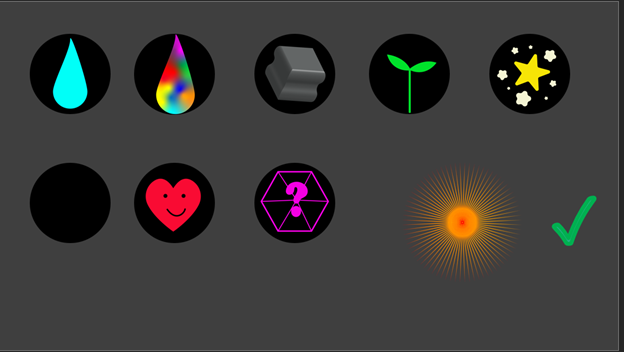
The explosion artwork was produced by using illustrators flare tool. The resulting vector image is quite complex. I think it crashed PowerPoint at least once. I got about a dozen “fake crashes” where powerpoint would think everything has gone terribly wrong, but it’s actually all fine and I can keep going. My best guess is that I was overflowing some clipboard buffer.
I made the PowerPoint slides in pretty much the order they appear in the presentation. I put a fair bit of thought into the path I was going to take explaining… I’m surprised I didn’t end up rearranging much in later passes. {One of my quirks as a writer is that many things initially get written in the wrong place… reorganizing is an essential part of my process}.
I’m going to divide the challenges of making this presentation into micro and macro… designing each slide and considering the overall shape of how I was teaching the system.
Here’s a sampling of some of the interesting microchallanges
- I need to precisely fit the correct amount of content on each slide: both visually and with respect to the 10 second timer
- Too little and a player will be bored… more importantly the game would be slacking on its core challenge
- Too much and that slide is unfair. This is the most egregious mistake to make because every successive slide depends on the previous stuff.
- The goldilocks zone is actually subjective! Everyone reads at different speeds and parses information differently. This means I need a margin both ways, which is pretty difficult. It is especially troublesome because the 10 second timer is not negotiable. Luckily my decision to invite the players to cheat at their own discretion really makes up for this. I don’t even need to ship a no-timer accessibility version of the game… you can just do it yourself!
- How do I balance “evil” design and good teaching?
- I knew I wanted to fill the presentation with things that would feel slightly unfair to expect the player to remember on the test. I had to be careful not to go overboard on this, the #1 priority was actually teaching each concept
- I had to make sure I was using a variety of tricks. Different people would be caught off guard by different things, and it would feel incredibly frustrating for someone to keep falling for the same thing. I had to balance this with trying to keep the presentation cohesive generally {if the slides weren’t cohesive enough that would be a distraction that unfairly costs time}
- What is the role of comedy here? It’s actually a form of evil design in this case… laughing at something surprising or pausing to consider amusing implications costs incredibly valuable seconds. I put in quite a few “gotcha” details, where if you make the mistake of thinking about them, you’ll just have more questions.
- How do I judge if a diagram makes sense? They all make sense to me 😉… I’m not the one who will be seeing them for the first time under a strict time limit.
- The answer to this is playtesting. The best thing to come out of my playtest session was realizing how cursed my diagrams were… the issues were pretty easy fixes once I was aware of them. The most significant changes on my 2nd pass through the presentation after my playtest session was reworking almost every diagram.
- i. It is a sin to make a diagram with no title chill alone on a slide.
- ii. Carefully consider how much diagram you’re stuffing into one slide. Playtesting revealed where it was important that I split diagrams into more slides. Using 2 diagrams on the same slide is dangerous, use caution. {The most reasonable use of this is where I showed an example that broke a law and an example that doesn’t break the law}
- It is also not trivial to avoid breaking alchemical laws with random examples. I had to put a surprising amount of care into ensuring that each diagram only broke a law when I wanted them too.
- The answer to this is playtesting. The best thing to come out of my playtest session was realizing how cursed my diagrams were… the issues were pretty easy fixes once I was aware of them. The most significant changes on my 2nd pass through the presentation after my playtest session was reworking almost every diagram.
Here’s a sampling of interesting macro-challenges
- How do I convert my outline to a linear collection of slides. My notes are a collection of concepts bound together, they must become a slideshow that goes in sequence.
- What order do I teach these concepts in?
- How do I find the “starting points” of concepts that do not need other concepts to make sense
- When should I be going into specifics and when should I be describing general things?
- How much should I tease concepts that haven’t been explained yet? There are two main approaches to take here: talk about the yet to be explained concepts as a natural part of the present so that they will feel like they fit once they arrive… or avoid getting ahead of myself to ensure that the present concept has all your attention. Both of these approaches are valid, my presentation has a mix of them. {This is also something I struggle with when teaching boardgames!}
- When do I stop? Even if I run out of notes I could enjoy discovering more about the magic system and world with each slide. What is a good scope for the amount of information and concepts I can expect a player to have capacity for?
- It was a complete coincidence that the natural point where I was satisfied was 30 slides. Exactly 5 minutes! This was incredibly aesthetically pleasing to me, and I’m disappointed that I added 3 more slides while I was doing revisions after playtesting.
- How do I manage complexity and avoid overwhelming the player?
- Difficulty from complexity is a compounding effect. The complexity of the whole thing is MUCH bigger than the complexity of each part. This is something that I feel applies to game design generally. One of my focuses as a game designer is the way different ideas interact, especially the ecosystem they create together. The contribution of one mechanic is rarely simple.
Slideshow Comments
For this section I’m going to go through the slideshow again, and stop to write comments whenever I have something interesting to say about one of the slides.
Slide 2: “Successful students take notes!”
This is deliberately vague and unhelpful. I feel like I’ve had dozens of teachers tell me how important it is to take notes without elaborating. Maybe this approach is for the better since everyone takes notes differently. I certainly prefer this fending for yourself to forcing a note-taking style onto people. {I’ve never had a notetaking method forced onto me end up as something helpful… in that class or in future courses}
Slide 3
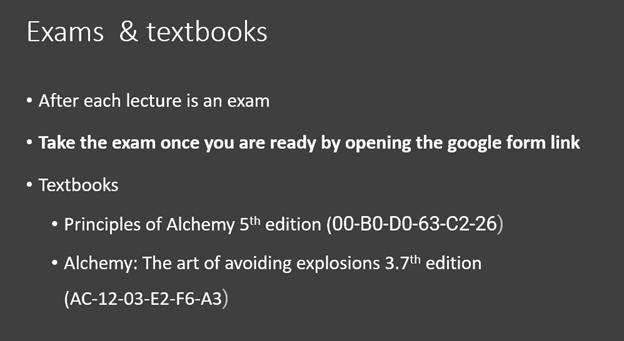
These first 3 slides are mostly meta slides to make sure people understand what they are doing in this presentation. Really the only important thing that was left to say on this slide was that there was an exam after the presentation. It’s redundant here though because the game page also explains this. Since I knew this slide really wasn’t particularly relevant, I had fun using up real estate to take jabs at college textbooks. Notice the hustle of making you buy a specific edition. The 2nd textbook is two attempts at something that could distract you. The name is decently amusing, and the edition number makes no sense. Fun fact: The fake isbn numbers are actually mac addresses. This was just to be quirky and different, another cheap way to distract the player. I also like how the player has no idea if they need to write down the textbook names or numbers.
Slide 4 and 14
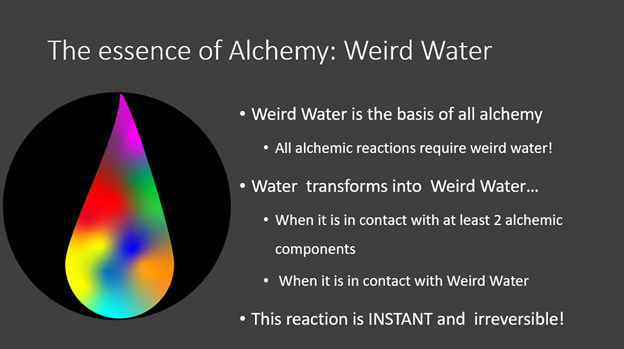
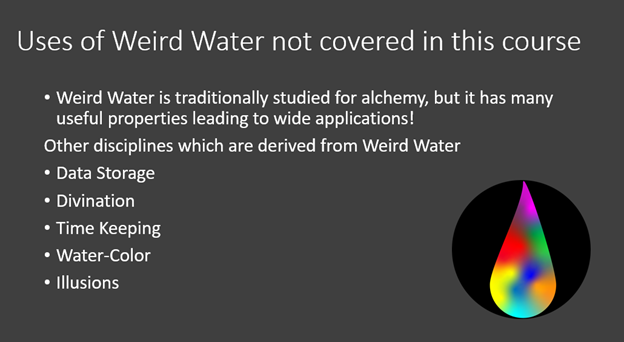
One of the test questions is a direct test of slide 14. It asks you which options from a list of fields use weird water as a basis for the discipline. It is endlessly funny how many people forgot alchemy when they answered that question. Based of their other answers, every single one of these people understood the role weird water played in alchemy, they were tricked into recalling this specific slide instead of accessing their conceptual understanding. Fun fact: weird water is designed to be the foundation of a magical style of computing. My love for computer science bleeds over to the way I design magic systems.
Slide 11
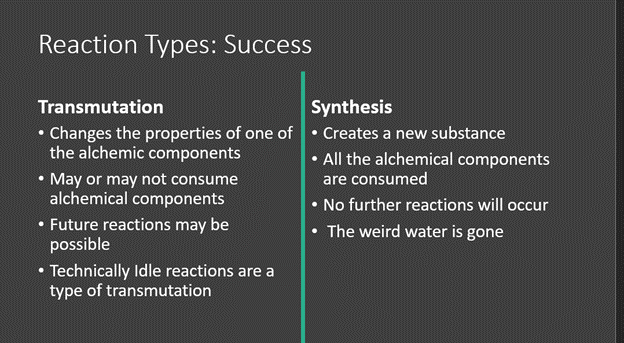
This slide is totally evil. It’s an intentional difficulty spike. I’m impressed with anyone who answered its corresponding test questions correctly.
First of all, I’m introducing two different types of successful alchemical reactions out of nowhere.
Next, there is too much text on this page to read it all
The hardest part is conceptually understanding the high-level difference between transmutation and synthesis in just 10 seconds. The format and wording of this slide is pretty unhelpful for arriving at the true core of this concept, even though it’s a pretty intuitive distinction once you understand it. Since this slide is an intended difficulty, I made sure that no future slides relied on this information. I also made sure that no more than 2 test questions would care about this slide.
The truly evil thing this slide does is the bullet point that says “Technically Idle reactions are a type of transmutation”. This is incredibly easy to miss, so naturally I made a test question for it 😊. It is also a contradiction with how the player understands the system: idle reactions are depicted as a different type of outcome than successful reactions. Here I’ve gone and said that idle is a fake category of reaction. This is like explaining to someone that during the day you can see the sun, during the night you can see the stars… and btw the sun is a star (then you leave before you elaborate).
There are 2 design decisions on this slide that are supposed to be in the player’s favor. I used the side-by-side structure and especially the blue line to make it immediately obvious that two different concepts are being compared. Then the evil bullet point I just talked about has no corresponding point on the right, it is the lowest text on the slide. This naturally draws your attention to it!
Slide 12
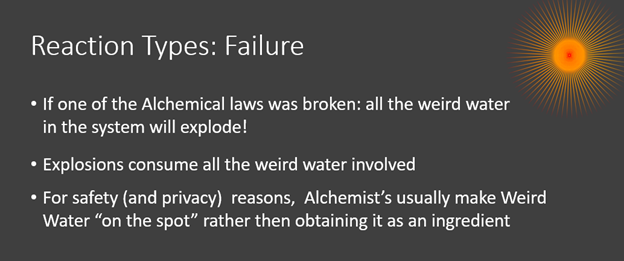
One of the people who played this was a friend who studies biology. It was really fascinating for them to tell me that a lot of the concepts here have real world analogues. He said that the idea of making weird water on the spot is similar to the concept of “in situ synthesis” where dangerous chemicals are made directly for their purpose in a reaction instead of being stored or transported.
Fun Fact: The in-world classification system here is actually misleading. In the same way that idle reactions are technically a type of transmutation, explosions are a type of synthesis. All reactions are technically “successful” reactions, just society doesn’t see explosions as helpful. That’s a huge barrier to discovering combustion. {Although the test suggests that alchemical explosions are commonly used for weapons}. The in-world Nature understands this… stars and stomachs are just alchemical reactors that intentionally use explosions.
Slide 15 and 16
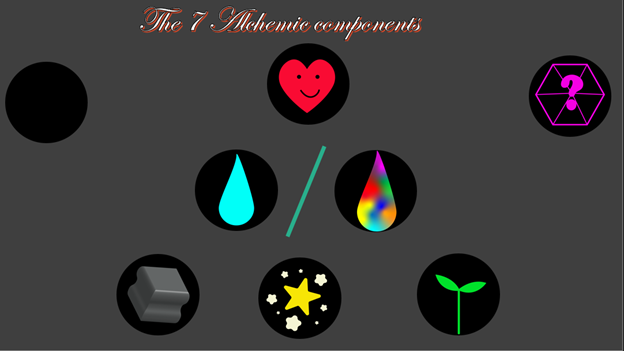
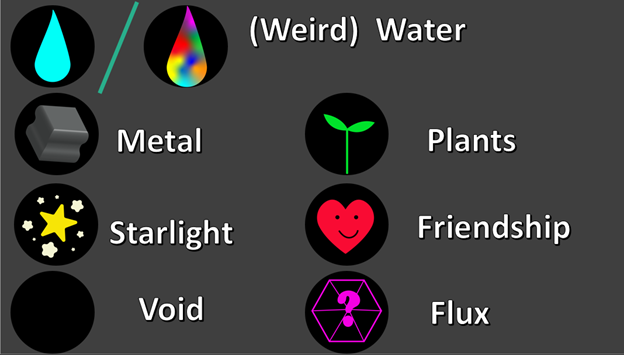
I thought It was quite funny to make the player spend 10 seconds trying to guess what these symbols were, and then reveal the names.
I also ended up abandoning my original hexagon structure. Here at the bottom we have the 3 “normal” components. At the center is (weird) water which is the basis of everything. The top row are the 3 abstract /magical components. Void and Flux are far away to show their role as utilities that change the balance of ingredients.
Slide 19 and 22:

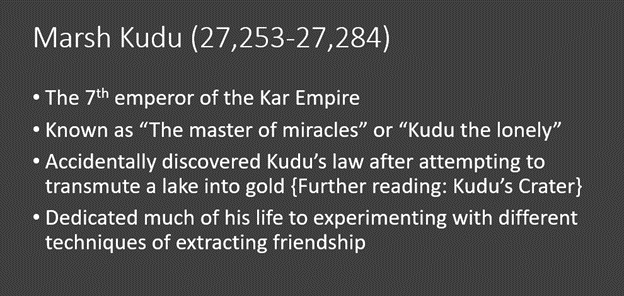
Most people will encounter this biography slide and intuitively find it less important than the other slides. Of course, since the test is meant to be evil and unfair it disproportionately tests on the biography slides. These slides are crammed with diverse information while being full of potential distractions. Another huge difficulty spike.
I came up with the unit Qx while thinking about the implications of Qluix’s law. That’s why the law is named after her. Originally in my notes it was “the law of anti-balance”. The abbreviation Qx is meant to feel exotic and memorable. Qluix was just my attempt to fill in a weird sounding name with those letters. The first name Miriam is a reference to the witch in wandersong. One of the truly evil test questions uses a name really close to Miriam Qluix (Mia Quix), it’s easy to not notice.
I actively made the founder of scientific alchemy female. Real life is already full of men pushing women out of history, no reason to let that be something that is inherently true in fantasy.
I also really like the contrast between the way alchemy is depicted in this slideshow and how it was implied to be viewed before anyone understood alchemical laws. I like the idea of this silly system with tons of explosions being something that people have put in the effort to understand and master.
The birth and death dates at the top of the slides are a distraction that I particularly like. First of all this, world uses a different calendar system. The large numbers are meant to make you do a double take. Then Miriam seems to have lived for ~330 years. She must have used that alchemy knowledge to live a long life. Finally the ones digit in her death year is a ?. If you stop to think about that the slide will be gone before you know it.
Notice the lifespan of Marsh Kudu is much shorter, only 31 years. It is heavily implied that they died young experimenting with alchemy. Their entire life is just a small section of Qluix’s life. That is weird to think about! I wonder how a world where people have vastly different lifespans like this would treat history differently.
I think the details about Marsh Kudu are pretty funny and evocative. He’s a memorable character that I made just to make a few test questions off of. He deserves more, I feel like this slide begs me to write a story about Kudu. I feel like a lot of the details here are rich with implications. I particularly like the footnote about Kudu’s Crater, in the context of accidentally discovering an alchemical law.
The name Marsh comes from a character in the mistborn series. The name Kudu comes from a random guard that appears in like one scene of the first dune book.
My favorite joke in the entire presentation is going from this slide that’s says “He dedicated much of his life to experimenting with different techniques of extracting friendship” to the next slide about friendship, which opens with “There are no known ethical techniques for extracting pure friendship”.
Slide 24
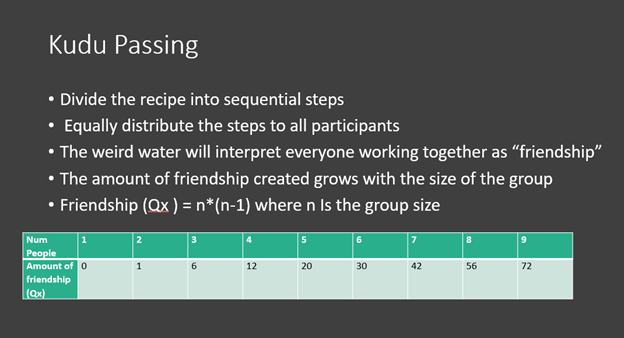
The key information you need for the test shows up in two different ways on this slide. You can either memorize the formula or remember the chart. Both of these are pretty hard to do in the context of 10 second timer. The corresponding question on the test is very frequently missed, with many people putting in just random numbers.
Having to equally distribute the alchemy steps to each participant sounds like an interesting challenge. I might revisit the way friendship works here in a future game.
Finally, regarding the last few slides, I think I should have spent more time explaining void and flux. Based on the test responses very few people understood these components. Alternatively, some of the nuances of these components could have been cut. I don’t like that approach because my favorite test question asks players to apply the properties of flux in an interesting way.
(Play) Testing
After I finished the presentation, I did three things: message a friend to see if they could playtest, eat dinner, and start thinking about the test. I decided that here was my chance to do some actual programming. I could make a c++ console application to serve as the test. I was about an hour into programming that when my friend was ready to jump into a call for playtesting.
This was the first time I’ve managed to get someone to playtest while making a game jam game. Just this one playtest was immensely helpful. Shoutout to my friend for testing my alchemy lecture at 2am.
A playtest does more than just show you a list of problems and mistakes you’ve made. This playtest also helped me understand how to think about the game, gave me guidance for making the test, and gifted me some confidence in the idea.
The playtest allowed me to create the dichotomy of “evil vs teaching”, dividing the streams of information between challenges and footholds to help the player. This was something I was thinking about while designing the PowerPoint presentation, but here the concept became much more concrete in my mind. One big thing I cleaned up in my 2nd pass through the slideshow was most of the times I had been accidentally evil. All the distractions and difficulty spikes are now slides I’ve internalized as intentional.
Next, seeing what someone struggled with was perfect inspiration for the test. It was really neat to do a playtest of just the teaching component, it naturally showed me what I wanted the test to be about, especially questions that would be absolutely evil to ask on the test. I think this might be worth internalizing as a general game dev rule: seeing how people learn your systems is a great way to understand how you want to challenge them. I wonder if I’ll work on the tutorial first in any of my future projects, it is certainly an interesting shakeup to the process. {Many people leave the experience of learning the game as one of the last parts, this is something I am becoming more and more interested in subverting with my designs}.
I also realized that it would be incredibly interesting to see the responses of people who took the test. So I scrapped the program I had been making for about an hour, deciding to implement the test in google forms. This was an amazing decision.
- It meant that I could spend 100% of my test development time on question design and writing
- It makes the test 100% accessible to any audience. If you can access the webpage where the game is hosted, you can access a google form
- A google form is much better at aesthetically feeling like a school test than my console application would have been
- I got to see everyone’s responses 😊. This was not only fascinating data for question responses, but now I have a solid number of how many people finished the game. On itch.io, the game has 79 downloads… the form only has 33 responses.
Finally, playtesting the lecture finally gave me confidence. I had spent all weekend enjoying that I was committing to a silly and absurd idea, it was nice to see that it was actually interesting.
After sleeping on my playtest session (and PowerPoint revisions), I had one thing to do on Sunday: make the test. The test was without a doubt the most rushed part, I made it as the final sprint before submitting the game.
I used the vibes I had gathered from the playtest and then just started writing questions. Almost all of these questions are straight out of my head, there was really no revision process here. Quite a few of them are simply knowledge checks, the difficulty is from the PowerPoint not the test. In hindsight I think I leaned too much into capitalizing on when I could be evil, I wish I had more questions that tested the fundamental concepts and asked you to apply your understanding.
The bonus question is a great example of the types of questions that I should have put more off onto the test. It’s interesting to think about, people are very split on it, and it asks you to apply the properties of flux {and you have to figure out that flux is necessary yourself}.
The next best questions I made were the word problems in the “Wait why did that explode???!” section. They are the closest I get to testing conceptual understanding, although each question here is either too easy or unfair. I enjoyed writing silly scenarios for each of these. I think this gives a lot more personality to the test. {Writing these was like doing improv, I never said no to my brain}.
The question about Robyn and her violent revolution is a direct insert of one of my friends. It’s a ton of setup for what is actually a super simple question. There’s a part of me that really wanted to create this scenario, the actual question was a bit of an afterthought, and is not very interesting.
The lesbian question was completely unfair in a way I did not intend. This is the only question I changed after release. The original question directly mentions that they are having a picnic on grass. This introduces an alternate correct answer: that plant could have been the unintentionally added ingredient. After weeks of this question annoying me, I edited it to take out the direct mention of grass. Now it’s just vaguely unfair, an improvement!
I have one question which uses the format of “which of the following statements are true”. This is a great format for challenging test questions. If you want to make multiple choice hard, here is how you do it. In a normal multiple-choice question, you can succeed by either knowing every answer that is wrong or knowing what is correct. This format forces you to do both of these things, which is surprisingly more difficult.
That question also was entirely a test of the interactions between flux and void. I’m not confident those are explained well enough in the PowerPoint presentation, since this question is one of the most frequently missed.
Here is the distribution of scores. The 0 score is someone who had nothing better to do than take the test a 2nd time, intentionally getting everything wrong.
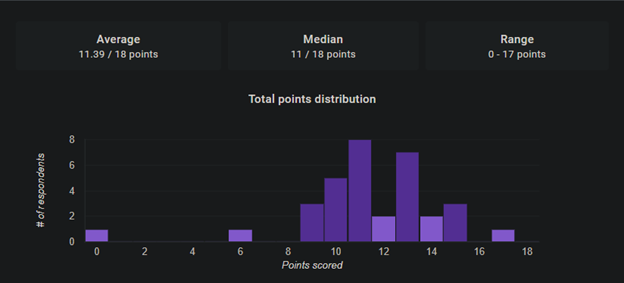
Release and Reception
Right before I submitted the game, I decided to export a video of the PowerPoint presentation. I choose to do this as accessibility in case someone couldn’t open the PowerPoint files. This ended up being a valid concern, 32 people downloaded the video version of the lecture. I was a bit worried that giving people a video would give them the freedom to pause it, but like I said earlier, cheating isn’t my problem {and the game is much better due to that decision}.
When I was filling in the webpage, I couldn’t decide if I had made a game or not. This is a pretty unique experience, so deciding how to classify it is pretty interesting. You can tell by the way that I’ve written this essay, I’ve committed to the stance of “this is a game”. My argument is that the experience of parsing each slide is gameplay. The test is just the “final scoring” to see how you did.
The response to this game blew me away, it is without a doubt the best thing I’ve made so far. The most satisfying part was reading comments and seeing that my intent actually landed for people. One of the highlights was getting a detailed stream of feedback from somebody who had professional experience with education.
There was also a day where I had somehow convinced a bunch of my friends to try out this game. It was a lot of fun to watch them all talk about it for a few hours.
I was shocked how well rated the game was. Ludum Dare has participants rate each other’s games in a few different categories. {Overall, fun, innovation, theme graphics, humor, mood} . My game got 2nd place in innovation! That feels incredible… there were 623 entries for LD 51 compo.
This is the first game I’ve made that I’m truly proud of.
Final Thoughts
- It is quite interesting to make a game where the target feeling is being overwhelmed. This is something that many complex games do accidentally, often hurting the experience. It is a fascinating challenge to seek this out, while trying to minimize the amount of frustration.
- There is a line of something being too overwhelming. Not crossing that line is the single most important thing to focus on in the design of games like this. As soon as someone crosses that line, they grow apathetic and just give up. The difference between a player who is invested but couldn’t quite catch everything and a player who gave up on understanding anything is huge. Minimizing the amount of the latter type of player feels like a huge design priority. This feels a bit counter-intuitive since the essence of the game is embracing an experience that is meant to be slightly frustrating and leave people behind.
- The best satire comes from love. This isn’t just me taking potshots at the problems of lecturing as a way to teach. I feel like being someone who actually enjoys lectures helped me both make fun of them while still trying to make a solid experience. Mocking something isn’t enough legs for something to stand on, I think it’s the wrong move to sacrifice the actual quality of what you are making in order to prove a point.
- I feel that the fun I had making this directly correlates to it being a good experience. The quality of the game comes from how much I was able to express myself. There’s value in pursuing the path of what you would enjoy making instead of what seems “good”. I also need to make more games with magic systems in them! It’s pretty interesting how making a magic system feels much more like game design than writing.
- It’s almost a shame that this is built around a 10 second timer. That’s the cute idea that convinced me to make this, but with the final product I’m now realizing how much interesting design space I’ve stumbled upon. Teaching a complex magic system is way more interesting than the auto-slide advance gimmick. They get a bit in each other’s way, I’d love to revisit this kind of idea while giving the magic system the full spotlight.
Get Magic-281: Intro to Alchemy
Magic-281: Intro to Alchemy
An overwhelming lecture for an absurd and complex magic system
| Status | Released |
| Category | Other |
| Author | Zachary Morris |
| Tags | alchemy, Ludum Dare 51, school |
| Languages | English |
More posts
- v1.01 Patchnotes (spoilers for a test question)Oct 27, 2022
Comments
Log in with itch.io to leave a comment.
Good stuff! I can see myself talking about this for hours because there are so many dynamic facets to it. Glad you enjoyed the process too.